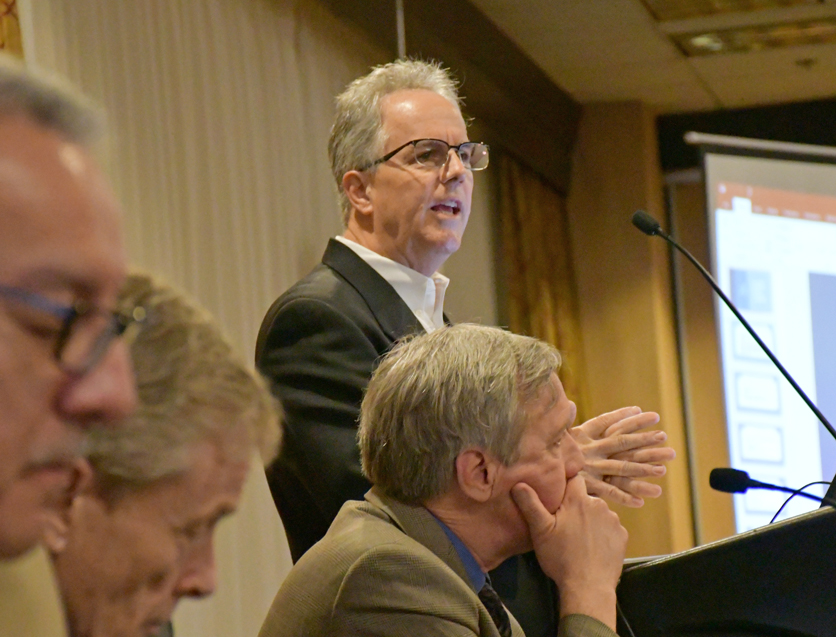Gov. Gavin Newsom’s administration last week released a framework for voluntary agreements (VAs) that seeks a compromise in the 50-year war over water flows. The most optimistic sign some version of agreements may be signed this year was the fact that no parties were happy with the framework.
The announcement delivered the first details from more than a year of intensive negotiations over water flows for the Sacramento-San Joaquin Delta. The continuous discussions have strung together officials from at least four state agencies, along with managers from a broad range of municipal and agricultural water agencies and advocates from conservation, sportfishing and environmental justice groups.
The framework proposes a 15-year initiative involving $5 billion, with at least $2 billion of that from the state. The plan would restore 60,000 acres of new and improved habitat for endangered fish species and aims to double the salmon population by 2050.
Four Democratic representatives from the Central Valley and Sen. Dianne Feinstein applauded the proposal last week. In a joint statement, they said a compromise over Delta water flows will better support habitat restoration while “providing certainty to California agriculture and other water users.”
Lawmakers, farm leaders and many others have been closely scrutinizing the early framework, which will likely serve as just the first piece to a much larger regulatory process.
“We're starting to see some great meat on the bones,” said California Farm Bureau Senior Counsel Chris Scheuring in an interview. “We're finally getting to a place where some voluntary agreements might actually be signed at some point in a way that derails the litigation and avoids the regulatory hard path.”
Scheuring said the biggest question yet to be answered is how the administration will pursue Delta operations for the State Water Project. In October, Newsom threatened to sue federal agencies over the new biological opinions governing Delta flows for the Central Valley Project. The administration has yet to file that lawsuit, to the disappointment of environmental groups. Any plan approved at the state level would still have to be approved in part by federal agencies, though those officials have shown support for the VAs.

California Farm Bureau Senior Counsel Chris Scheuring
“I don't know whether the state is pulling back from the brinksmanship they had a couple months ago,” said Scheuring, adding that he is concerned the administration would be pitting one water project against the other in that case.
Conservation groups have threatened to walk away from the negotiations unless the administration pursues that lawsuit or shows more dedication in pushing back on the Trump administration’s environmental assessment. Defenders of Wildlife Policy Advisor Rachel Zwillinger said the deal proposed last week does not meet the state’s environmental standards and will fail to gain the group’s approval.
“As far as we can tell, no one is very happy with the framework—and that may be a good sign,” write water policy researchers Ellen Hanak and Jeffrey Mount of the Public Policy Institute of California, in an opinion piece for CalMatters on Monday. “It is just not possible to satisfy all interests in the Delta.”
Hanak and Mount add that despite the framework’s “imperfections” it would provide certainty to both water users and the environment. They acknowledge that many Delta interests will continue to fight the same battles with the same arguments.
Scheuring also pointed out that environmental groups have “a pretty narrow interest set” in protecting fish, while the state must balance endangered species laws with existing statutes obligating them to deliver water to millions of people and farms.

California Farm Water Coalition Executive Director Mike Wade
The more valuable responses will come from public water agencies at the local level, as they assess these changes under their own operating scenarios, according to Mike Wade, executive director of the California Farm Water Coalition. He said the VAs could impact each agency differently.
“It's a lot more funding that's going toward environmental improvements than we saw a year ago,” he said in an interview. “And it's a lot more water.”
Wade pointed out that the new stream flows dedicated to fish are sometimes as much as three times higher than the proposals in the July 2019 progress report. Yet the administration has been taking an approach with its new proposal for the State Water Project, as well as a new single-tunnel plan for the Delta and the first draft of its Water Resilience Portfolio, of diverting more water to surface and groundwater storage during high-flow events. Wade said that could serve as enough of a cushion to help farmers through the critically dry years.
“So much of this is tied together,” he said. “It's exciting to see Governor Newsom work through this process to find solutions, rather than just punting down the field and hoping for a solution sometime later.”
Another question is how the regulatory process would move forward with new agreements. In 2018, the State Water Resources Control Board approved Phase 1 of its Bay-Delta Plan and has held off on a vote for Phase 2, pending discussions over the VAs. That part of the plan proposes unimpaired flows to the Delta of as much as 60% for environmental purposes. Yet it covers the north side of the Delta, where water districts “have more (water) to play with” to get to a path more protective of fish, according to Scheuring. The VAs would likely replace Phase 2 and perhaps serve as a substitute for the Phase 1 measures on the San Joaquin Valley side of the Delta, he said. Yet the approach established by the VAs would go well beyond the Delta.
“It's crucially important, because this is a new use of comprehensive water quality planning processes to regulate big picture flow issues,” said Scheuring. “What we get done here is the template for a lot of future actions on river systems around California."
For more news, go to: www.Agri-Pulse.com


